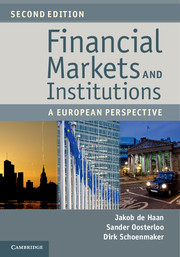Book contents
- Frontmatter
- Contents
- List of Boxes
- List of Figures
- List of Tables
- List of Countries
- List of Abbreviations
- Preface
- Part I Setting the Stage
- Part II Financial Markets
- Part III Financial Institutions
- Part IV Policies for the Financial Sector
- Chapter 12 Financial Regulation and Supervision
- Chapter 13 Financial Stability
- Chapter 14 European Competition Policy
- Index
- References
Chapter 13 - Financial Stability
from Part IV - Policies for the Financial Sector
- Frontmatter
- Contents
- List of Boxes
- List of Figures
- List of Tables
- List of Countries
- List of Abbreviations
- Preface
- Part I Setting the Stage
- Part II Financial Markets
- Part III Financial Institutions
- Part IV Policies for the Financial Sector
- Chapter 12 Financial Regulation and Supervision
- Chapter 13 Financial Stability
- Chapter 14 European Competition Policy
- Index
- References
Summary
Overview
Against the backdrop of the 2007–2009 financial crisis, this chapter discusses the growing importance of macroprudential supervision, which focuses on the stability of the financial system as a whole and therefore on the monitoring and assessment of so-called systemic risks.
The chapter sets out the key features of the conceptual framework for macroprudential supervision, which consists of: (1) the monitoring and analysis of the financial system; (2) assessing potential threats to fi nancial stability and deciding to take mitigating action, (3) implementing measures to actually mitigate vulnerabilities, and (4) evaluating these actions in order to ascertain to what extent vulnerabilities have indeed been diminished. Based on these elements, this chapter discusses the key indicators used by macroprudential authorities in search of potential vulnerabilities, as well as the main instruments available to address them. This chapter also discusses the emerging institutional architecture for macroprudential supervision in the EU and the US.
This chapter also touches upon the issue of crisis management and resolution, discussing the main reactive instruments that can be considered in crisis situations. Finally, this chapter discusses the key challenges related to the negative externalities caused by failure of cross-border institutions, including the need for ex-ante burdensharing arrangements between Member States.
- Type
- Chapter
- Information
- Financial Markets and InstitutionsA European Perspective, pp. 392 - 426Publisher: Cambridge University PressPrint publication year: 2012



